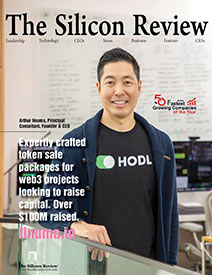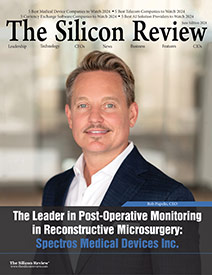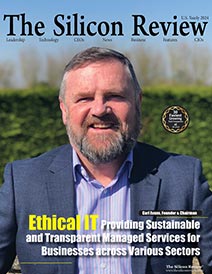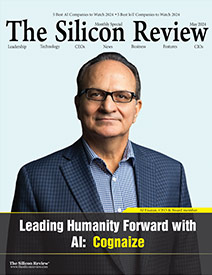50 Best Companies To Watch 2018
In the Spotlight: Sitetracker, the only full-lifecycle project management platform for smart infrastructure
The Silicon Review
![]() “Sitetracker enables America’s infrastructure providers effectively manage high-volume distributed projects in real time on one easy-to-use platform.” — Giuseppe Incitti
“Sitetracker enables America’s infrastructure providers effectively manage high-volume distributed projects in real time on one easy-to-use platform.” — Giuseppe Incitti
Sitetracker — the standard for innovative critical infrastructure providers — empowers companies like Verizon, Central Hudson Gas & Electric, and Intersection Media (an Alphabet company) to build the future faster. Created by expert project managers, Sitetracker is the world’s first full-lifecycle platform for managing modern, high-volume distributed capital projects and assets. Innovators use Sitetracker to plan effectively, deploy and maintain efficiently, and grow the value of their portfolios.
Incorporated in 2013 and headquartered in Palo Alto, CA, home of some of the greatest software companies in the world, Sitetracker also has regional offices in Montclair, NJ and New York, NY.
Interview: Giuseppe Incitti, CEO
What is Sitetracker and why is it important?
As the world becomes more connected, the volume, velocity, and variety of infrastructure projects are exponentially increasing. To meet these challenges, project managers need innovative technology solutions coupled with expertise in business transformation. We’re the only platform designed by project managers for project managers, built from the ground up to enable critical infrastructure companies across the world, like Panasonic, Tillman Infrastructure, and Viasat to deliver their essential projects on time and on budget. Our customers do this via real-time collaboration, powerful automated reports, and accurate forecasting. The platform enables our users to effectively manage high-volume distributed projects, with accurate real-time data, on one easy-to-use platform.
Every day, project and operations managers use our platform to maximize asset value and shorten time to revenue by managing the entire project lifecycle — including post-deployment activities such as maintenance, upgrades, and marketing. For example, Sitetracker users generate over 3.7 million project updates every week on our platform. With so many moving parts, it’s critical to work in a platform that minimizes the risk of failure and optimizes processes with automatic scheduling and assignment, shareable user-friendly maps, and collaborative document management.
We provide a platform for our customers to evaluate deployment locations in context and conduct capacity planning to identify staffing needs or resource bottlenecks. Our customers can leverage powerful reports and dashboards to connect project timelines with historical performance, accurately forecast milestones both at individual sites or across entire portfolios, and enhance accountability for vendors, subcontractors, and internal teams.
What are the challenges that infrastructure companies are going to face in the next five years?
We’re at an inflection point.
We are entering an era where citizens’ demand for constant and ubiquitous connectivity is driving the miniaturization of technology and the densification of critical infrastructure assets. In other words, connection points (cell-sites, sensors, etc.) are getting smaller and cheaper, unlocking new and exciting use cases. Deployment and project complexity are increasing. At the same time, profit margins are shrinking and project managers are being asked to do more with less. Consequently, winners in this new era will be companies which focus on operational excellence to connect strategic goals with tangible actions.
In the telecom industry, for example, carriers need more than just macro cell-sites. They need DAS (distributed antenna systems), small-cells, and fiber backhaul. Conservative estimates suggest that in the USA alone, project velocity will have to increase, as over 800,000 small cells will be deployed over the next five years. The expected effort to deploy them will be similar to the 300,000 plus macro cell sites built over decades.
Similarly, utilities are becoming “smart” and more connected in response to citizen demand. Innovations from smart meters to distributed energy resources (DERs) pose unprecedented challenges that must be solved through the adoption of new processes. All this comes at the same time as maintaining more than 180 million aging utility poles in the US alone.
Telecom’s faster project velocities and utility’s increased project volumes converge in smart cities, where the combination of new technologies and geographic dispersion create more project variety and exponentially more interdependence. Each of these — wifi kiosks with digital billboards, air quality sensors, pedestrian traffic monitors, and more — requires the coordination of dozens of teams, agencies, and vendors happening, necessarily, in public where project delays or issues are dramatically on display.
How does Sitetracker address these challenges?
Sitetracker is uniquely positioned to understand these challenges from our time as telecom consultants. In response, we created a future-built platform to manage the process of building the smart infrastructure of the future. We continue to grow as these types of projects — small-cells in telecom, DERs in utilities, and sensors in smart cities — become more ubiquitous in an increasingly connected world.
Sitetracker users can easily manage all high-volume projects with Intelligent Project Templates and report in real-time with powerful dashboards. They can update multiple projects at once with Trackers and stay on top of project financials with instant insights to expenses and revenues. Sitetracker boasts a 92 percent adoption rate amongst its users, which speaks to the fact that there’s a clear need for what Sitetracker offers. We’re humbled by our growth; our customers are our lifeblood and our absolute focus.
How does your company contribute to the global IT platform and society at large?
We enable an ecosystem of innovators to remove the roadblocks between ideas and implementation through our project and asset management platform. Ultimately this means that consumers can harness the power and impact of technology and connectivity to improve their lives.
What challenges did you face in your initial years? What can your peers learn from it?
In our earliest phase, our only impediment to growth was bandwidth. We were growing at such an accelerated rate that we knew we couldn’t continue to meet the demand and continue to deliver the same high-quality service to our customers without expanding our team.
So, we stepped back and decided to take a more strategic approach to growing the company — starting by ensuring we have the best talent to continue to build a platform that exceeded both our customers’ expectations and needs. We pitched NEA and secured $11 Million in Series A funding. Since then we have been able to scale our organization to be one step ahead of demand and customer growth ultimately exceeding both our team and customers expectations.
Tell us about your first product launch?
We started out as a small telecom project management consulting group and built a bespoke project management platform for one of our customers. The adoption rates were off the charts and we reveled in our success that first week. It wasn’t until the next week that we realized we hadn’t built in a self-serve password reset feature. We ended up spending more time refreshing passwords than anyone should ever have to.
Since then, we transformed into a full-lifecycle platform for high volume, repeatable critical infrastructure projects in fields like telecommunications, utilities, and smart cities. We always knew that operational effectiveness would be an essential differentiator for our customers, so we built a project management platform fit for our customers’ purpose.
Do you have any new products ready to be/getting ready to be rolled out into the market?
We recently released a slew of new highly anticipated features including collaborative document management and some mobile updates. We are focusing on making our platform the best it can possibly be and providing top-notch service. We are always innovating to meet the ever-changing market needs and release new features and enhancements roughly every six weeks.
What are the biggest assets to your organization? What would they be and why?
Our people and our customers. Both are are the backbone of our company.
Our customers constantly challenge us and our team is constantly surpassing their expectations. Without a doubt, our team is a massive differentiator. From our cutting-edge engineers to our dedicated customer success experts, our team embodies our passion and values, daily. It is because of them that we have never lost a customer.
We wholeheartedly embrace the notion that we are beholden to three groups: Sitetracker customers, future customers, and each other. By looking through this wider lens, we’re able to see the whole picture. We see what the status quo looks like, and work tirelessly to upend it. That’s exactly what we aim to do every day.
Our office culture is innovative and energetic, and everyone rolls up their sleeves to help their fellow co-workers, regardless of their titles. In spite of this fast-paced, action-oriented environment, some of the most notable company-wide changes we have made were suggested by our team. We give all ideas the respect they deserve and we foster two-way communication to ensure we get the best out of each and everyone.
Perhaps the most important advice I can provide is to surround yourself with a passionate group of talented people who aren’t afraid to argue their opinions. By checking your own ego at the front door and fostering that in your culture, you will ultimately make better and more informed decisions.
We see every interaction with each of our customers as a chance to showcase our commitment to them and are grateful for that opportunity.
The Man At The Helm: A Brief Background on CEO
Giuseppe Incitti: Responsible for developing and executing the Sitetracker corporate strategy as well as managing all aspects of operations, business development, partnerships, corporate development and corporate finance, Giuseppe previously served as the Vice President of Worldwide Operations at MongoDB after joining the company’s Financial Planning & Analysis team.
Before MongoDB, Giuseppe led the corporate development group at TIBCO Software where he led their acquisition and venture investing efforts. Giuseppe’s earlier career experience includes equity research, strategy, and merger and acquisition positions at Morgan Stanley, JPMorgan Chase, and Deutsche Bank.
Winner of multiple prestigious awards, including Best CEO for Small and Midsize Companies by Comparably, Giuseppe holds a Master of Engineering in Systems Engineering and a Bachelor of Engineering in Mechanical Engineering from Stevens Institute of Technology.
“The combined experience of each and every person in this organization has led us to the success we see today.”









